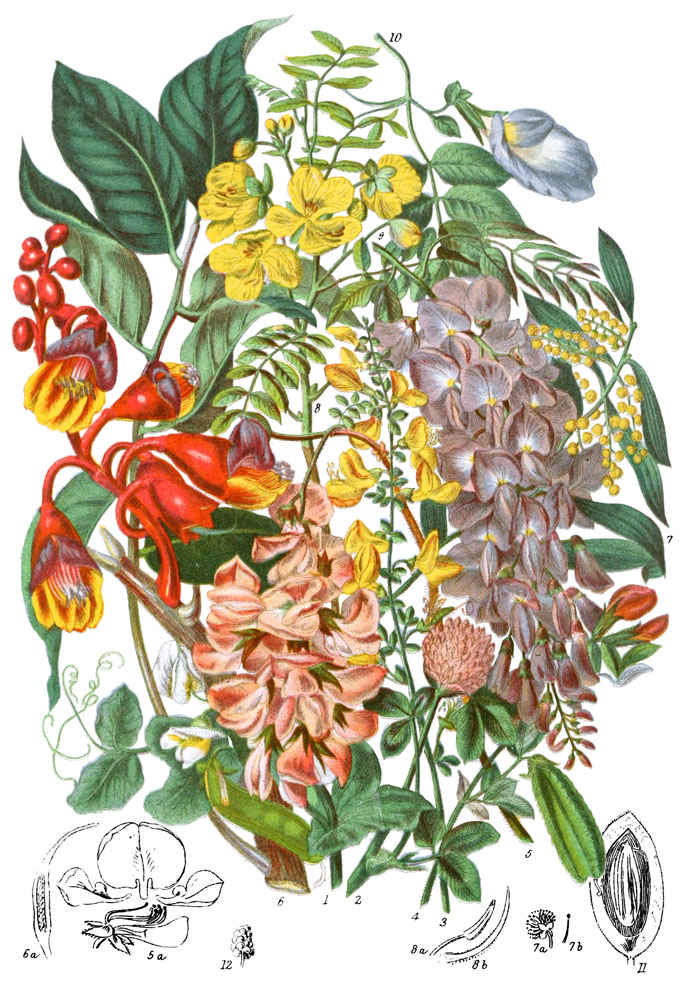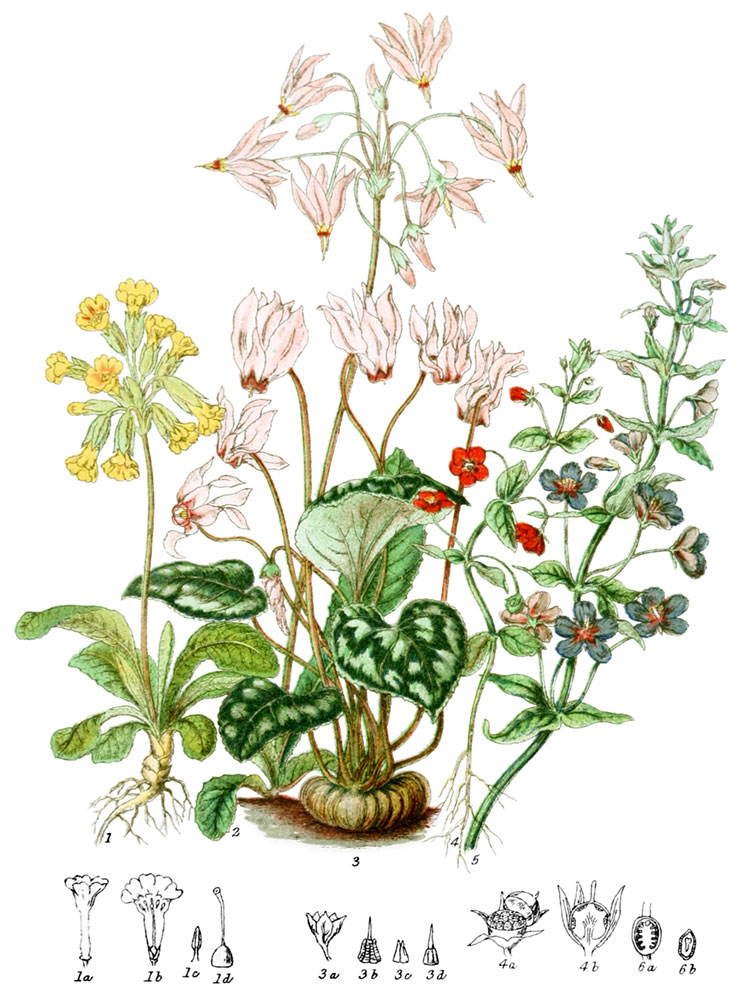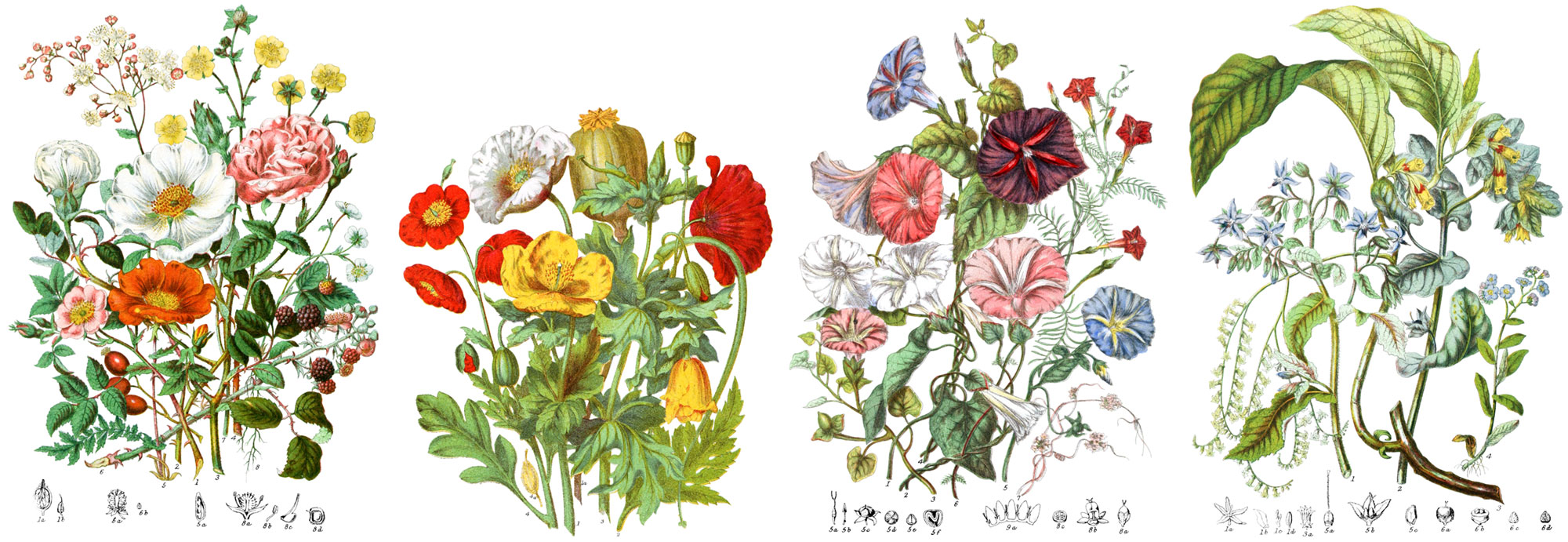Conclusion
This conclusion was written by Elizabeth Twining and has been enhanced with callouts to highlight key points, illustrations, and links to more information.
A desire to illustrate and describe in simple language the chief Natural Orders of Plants which embellish our world is now fulfilled: the attempt is accomplished, though in very humble and imperfect manner.
But so vast and varied is the mass of vegetation covering the land, filling the deep oceans and the shallow waters, that to select a few examples merely as guides to a more extended research in this field of study, is a perplexing task. Still the labour has been repleat with interest and delight; the more we examine the glorious works of an Almighty Creator, the more we perceive their excellent beauty and endless variety. In our endeavours to comprehend something of His works, we cannot fail to observe not only the infinite power of the Creator, but the finite capacity of man. In striving to arrange Plants into tribes and groups, by which to obtain clearer views of their structure and properties, we find how countless are the links by which Nature connects all things together. Large classes may be formed of certain assimilating Plants for our guidance in botanical studies, but almost imperceptible chains combine them into one grand whole; there is not a plant in the entire range of vegetable life that has not affinity with others in structure and organization. Even the two great classes of Animals and Plants are so imcomparably blended, that the most learned naturalists of this ninteenth century have scarcely yet accurately defined their respective limits. The lowest plant in the scale is a simple cell, with a few fine hairs, having a peculiar power of motion for a short space of tiem before it actually becomes a living, vegetating plant; thus for a time most clearly connected with the Infusoria, the lowest form of animal life. In this, as in all other studies, the truth becomes clearly evident, that this world is intended as a place of learning, a time for searching after wisdom; and in this search we must ever ben occupied for our own individual benefit, and, if possible, also for the aid and guidance of others.
In taking a comprehensive survey of the natural tribes of Plants, as for the sake of distinction we call them, we may acquire more just and extended notions of their dispersion and varied utility. Very essential is this enlarged idea of all natural objects, especially in instructing the young. We esteem highly the advantage derived from the use of improved microscopes, which afford a more accurate insight into minute and complicated organizations. Valuable, also, is it to take a comprehensive view of the wide-spread vegetation of the world, not to confine out thoughts into one portion in our own country. A child soon learns to know the common Plants about his home; he sees Nettles, and is told they are useless weeds, and sting painfully. It would be well to teach, at the same time, that there are, in hotter countries, some plants very like them, which are of great use to the natives; and that if we had not hemp and other plants with strong fibrous stalks from distant lands, we might makea very good string and paper from the despised Stinging Nettles.

Concerning the structure of Plants, these Illustrations can only indicate the principal points; on pursuing the study, very remarkable arrangements will be evident, and the cause of several common appearances ascertained. The reason why leaves, which in spring are frequently withered at the points by frost, continue to enlarge afterwards, is because they grow always from the base, so are not impeded by partial check at the point or edges. The cause of roots being able to penetrate into very small crevices, is, that their power of growth is at their point. The vital force of vegetable matter in its earliest growth is immense in proportion to the size of the cells and the tender nature of simple cellular substance, not strengthened by fibrous tissue of any kind. A soft succulent Fungus can make its way through the hard earth of a well-trodden road in dry weather. One of the most wonderful properties in the structure of Plants, is the power of absorbing moisture after a long drought, and apparently a complete withering of their substance. This is exemplified in a very striking degree in Anastatica Hierochuntia, the Rose of Jerico, belonging to the Leguminous Tribe. It grows in the arid deserts of Palestine and Arabia; after flowering rolls up with the seed-vessels into a dry ball. The wind soon uproots it, for it has very slight hold in the sandy earth, and drives it along till it is fully deposited in some pool of water. There the dry tissue begins to expand with the moisture, the branches unroll, and the seeds, falling into the water, are prepared to germinate on the borders. The cells of vegetable tissue have, moreover, a strong power of contraction, which may be proved reaily by one of the most common weeds, found in every garden. On breaking the stalk of the Spurge, or Milkwort, the milky juice is expelled from each end, by the cells containing it immediately contracting.
The geographical distribution of Plants is a subject of extreme interest, and the observations to be made thereon add much to the pleasure of all travel.
Mountain Plants more especially require suitable localities, and are in many cases obviously adapted to their exposed position, often clothed with fine down or hair, and having short, firm stalks, well calculated to resist wind.
One of the most elegant speciments of our mountain Flora is Primula farinosa, to be seen on the hills of Yorkshire, growing also in the Alps, and, across the Atlantic, in North America. It will be found, likewise, in themost southern land of South America, near the Straits of Magellan, but nowhere on the intermediate hot plains; it traverses the vast continent from north to south, along the elevated chain of the Andes, whre it meets with a favourable climate.

Another curious fact connected with the geographical dispersion of Plants, is that some species belonging to Temperate countries gradually diminish in size appraoching towards colder countries or more elevated situations. The tall Ash-tree of Britain becomes a mere shrub in the chilling atmosphere of the Arctic retions. The Birch, growing to the height of forty feet in our moist woods, is not more than twenty feet high in the Pass of Killcrankie, in the Scotch Highlands, below 57° of north latitude. In Iceland, in 62° of north latitude, it dwindles to a low bush of three or four feet. But if we turn our observations toward the Tropics, the change will be different; we shall find Nature developing her objects on a larger scale. What we have notice din our native examples will appear like miniature specimens. All we know of the genus Cuscuta Dodder, here, is a little plant just springing out of the ground, but soon entangling its delicate slender threads, bearing small clusters of pale flowers over the Heath and Furze of the common; in the hot, damp jungles of India, this genus is expanded into a species of vigorous growth and considerable size, climbing over forest trees with stems as large as small rope. The peculiar properties of some plants are more perfectly developed in some situations than others; the aromatic qualities of Alpine plants particularly, require the pure air and uninterrupted rays of the sun. Certain plants we are accustomed to consider as merely ornamental, employing them only to adorn our gardens and houses with their gay flowers; Begonia is one of these, abundant in every conservatory, and not though of as yielding any useful service; yet a traveller on the Himalaya mountains may find growing there a yellow-flowered Begonia, with succulent juicy stalks, which the natives cut up into pieces and make therewith a pleasant acid sauce for their curries.
Besides the innuerable observations and topis of interest connected with the higher tribes of flowering Plants, the more humble and less developed are not without value as objects of study and inquiry.

Even the lowly Fungus Tribe, to some known only as containing eatable Mushroomts or poisonous Puff-balls, is found on examination to be abounding in curious forms, and sometimes possess also brilliancy of colour. The simplest species when magnified are seen to be of graceful form, exhibiting tracints of shape and pattern, equalling in beauty and elegance the most renowned designs of ancient art, and capable of affording valuable hints to modern artists. The common Fungus, known as mould on paste and other similar substances, is composed of fine filaments, bearing perfectly round heads full of minute spores, each complete in itsself, though only one four-thoustandth part of an inch in diameter. The Yeast Fungus which, in growing from granules of starch, evolves gas, and causes beer to ferment and dough to swell, is composed of globules one three-thousandth of an inch in diameter. So marvellous is the plan and structure of even the smallest object of vegetable creation.

Of the extensive Tribe of Sea-weeds it is impossible, within the narrow limits of a single page, to give more than a very slight idea, either by figures or words. The waters have their plentiful store of wonderful works as well as the land, and display very interesting objects to our notice. Many Sea-weeds possess considerable beauty when beheld in their native element; one of the most singular, and unknown on the British coast is Claudea elegans; the fronds bend gracefully, and are formed of an open network, in some spaces of which the clusters of spores are placed. The circular frond of Martensia has a border at th eedge, having the appearance of lace. There are zones of particular Algæ, clearly defined: the Mediterranean has its own species of Sea-weeds, whilst different speciments are found in the Red Sea. Some produce their delicate branched fronds on rocks near the coast; other extend their unmeasured length in the deep waters of the Ocean.
Respecting the causes of colour in Plants, many points have yet to be studied and elucidated.
We known not how or why some flowers change their hue during the short period of their existence; neither why others, as Cobœa scandens, should bear green flowers, which only become purple after they are fully expanded. Nor can we explain why one flower, as a Rose, has its full red hue even whilst the petals are closely enfoled in the calyx concealed from light. This is contrary to a theory concerning red colour of flowers, which supposes that a strong and pure sunlight is necessary for the development of red. Therefore, in our temperate atmosphere of light and heat we have only two native flowers, the Poppy and the Shepherd’s Clock; whilst in the Tropics, flowers of the most brilliant crimson and scarlet tints abound. We can only observe the facts; chemists and botanists have yet many things to explain by their united researches. We cannot fully declare the reason why the power of acquiring blue colour should decline with the vigour of the plant; but we may remark that it is so. The first flowers on a plant of Ipomæa purpurea, commonly known as Convolvulus major, are nearly all of a fine blue or purple, but towards the close of its existence in autumn, pink and white flowers prevail; if a blue flower is found, it will be of a very pale tint. So also with the Forget-me-not; it must have favourable circumstances for vigorous growth, to enable it to acquire the celestial hue for which it is so much admired. Place a plant of it on a vessel of water or earth under glass, it will flourish for some time; but gradually as the flower-buds unfold, they will lose the property of becoming blue, and remain either pink, as all those flowers are in the bud, or become white. This is very remarkable, and so likewise is the fact that blue-flowered Plants are the most apt to produce white varieties.

Great truths are oftentimes revealed to us by very humble means.
Not only does the contemplation of the various laws which regulate the organization of Plants fill our minds with wonder, but we must adore also the Wisdom which provides for the future as well as the present state of vegetation; marvellous is the ample provision made from the beginning of creation until now for the security of its continuance. “The fruit-tree yielding fruit after his kind, whose seed is in itself,” was the work of the third day of creation; the word went forth, and is still obeyed. Notwithstanding the many casualties that are ever liable to befall plants and their seeds by animals or insects seeking them as food, yet no one is lost from the face of the earth. The fruit of the chesnut contains fourteen seeds, one or two only of which suffice to ripen.
Great truths are oftentimes revealed to us by very humble means. The actual living Plants of this present time tell of an omnipotent Creator; they lead also to the knowledge of the relics of a former vegetation, the work of the same eternal Maker, in ages eyond all other records. There are sealed herbals in the depths of our rocks and coal-mines which show us preserved examples of Ferns and various delicate foliage, kept save amidst the overwhelming wreck of the world. After the lapse of countless ages again brought to light, they tell of the past, and make known the character of the Plants that adorned the earth in a former state of its existence. Sometimes a close similarity is perceptible between past and present species: in the Museum of Carlsruhe, in Germany, may be noticed a specimen of fossilized Isoetes, so nearly resembling that which now grows on the edges of pools in the neighbouring Black Forest, as to leave no doubt of its identity as a genus. In some countries parts of fossil Plants have been discovered, differing widely from those of the present time. The strata of the Isle of Sheppey, at the mouth of the Thames, contains the remains of the fruits of Palms and other Tropical trees, which no longer grow in our Temperate regions.
Thus Time, the destroyer, is also the preserver—soft fruits and fragile leaves, whose nature is to perish in a summer season, in the course of unnumbere dyears have been converted into rock, and thus destined to enlarge our knowledge of the past, and to prove the existence of vegetation in remote periods beyond the scope of our chronology. Whether we consider the giant trees of the Tropics, whose age is unknown, or the ephemeral Fungus, whose existence is but for a few hours on the surface of the earth, or penetrate into the hidden recesses of rocks and caverns, and behold the things that belong to the past, we are lead to the one source—to Him in whose sight a thousand years are but as yesterday, when it is past. The beautiful and innumerable proofs of Divine Wisdom displayed in the vegetable creation may well excite our unbounded admiration and revernce, and beholding the wondrous preparation of many excellent things for the service of man, so much spread forth for our delight and enjoyment, with fulness of heart we may join in the ancient canticle, “O, all ye green things upon the earth, bless ye the Lord: praise Him, and magnify Him for ever.”
Nearly all the drawings have been made from nature, whenever living speciments could be procured, collected in various places. To the Royal Gardens at Kew, and the Botanic Gardens of London, as well as several private gardens, I have been largely indebted for examples of foreign plants. The native specimens have been culled in fields and woods in all parts of our contry. From the unpublished drawings of Sir Robert Schomburgk I have been kindly allowed to copy the Alexandra, Barbacenia, and other rare South American flowers not yet to be seen in English gardens. From Dr. Lindley’s “Vegetable Kingdom,” Dr. Royle’s “Illustrations of the Botany of the Himalaya,” and several other published works on Plants, descriptive as well as illustrative, I derived much valuable assistance, endeavouring to extract and glean such materials as suited my purpose, rendering all into simple words that may be comprehensible to the unlearned, and, if possible, lead to greater pleasure from the possession of such beautiful gardens as rare as the undisputed pride of our island. Moreover, I trust in all humility, yet earnestly, that this mite, cast into the treasury, may be prospered in its results, and lead the ever active mind of young to search diligently, each for himself, and to inquire with sincerity of purpose, and the true intention of the patriarch of Uz, “Where shall wisdom be found, and where is the place of understanding?”
E. T.
London, 1868.
Posters
Decorate your walls with colorful detailed posters based on Elizabeth Twining’s beautiful two-volume set from 1868.
Puzzles
Challenge yourself or someone else to assemble a puzzle of all 160 botanical illustrations.